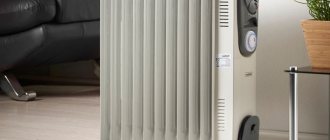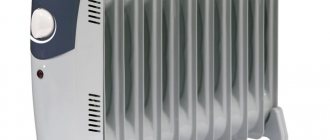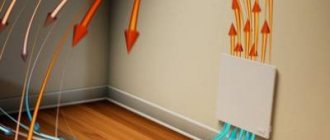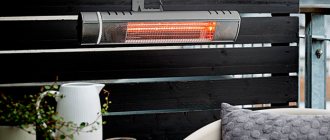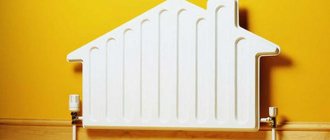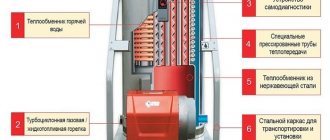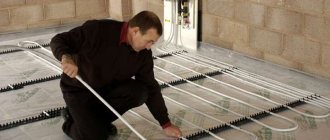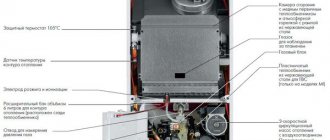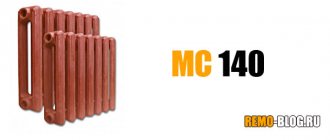Design and principle of operation of the fan heater
A fan heater is a modern version of a reflector, which was widely used earlier, 30-40 years ago, to heat the air in an apartment or country house.
The modern fan heater is very popular among consumers. This is an inexpensive but very effective device. It can quickly warm up the air in the room and thereby make the environment comfortable.
It is not difficult to guess what the principle of operation of the device is. This is clear even from the name. After all, the air heated by the electric element is supplied to the room, since the built-in fan operates.
- Wall-mounted. - Floor-mounted. - Ceiling-mounted. - A device for thermal curtains, which is usually located above the door.
1. Electric spiral. Can heat up to 800 degrees.2. Ceramic tile. Can heat up to 200 degrees.3. Tubular heater. Operating temperature is approximately 200 degrees.
Fan heater
If you look from a technical point of view, it is difficult to understand what is the difference between these devices: they both “drive” air using its circulation. Warm flows go up from the unit and displace cold ones down - and so it goes in a circle. However, there are still differences. The fan heater is easy to operate and affordable for most consumers. This device can be found in the following versions:
- desktop;
- with placement on the floor;
- ceiling modification;
- "thermal curtains".
The work goes like this: a fan forces air through the heating element, from where it is heated and enters the space. There are different modifications of the main part:
- electric spiral heated to 800 degrees;
- ceramic tiles with the ability to heat up to 200 degrees;
- tubular heater with the same temperature.
Of all those mentioned, the models that have received the greatest praise are those that have a ceramic heating element - in this case, the heat is supplied in a “pure” form, without combustion byproducts.
Advantages of the device
There are many advantages that a fan heater device has.
- Warm-up speed. If you choose the right power, you can achieve a warm atmosphere in just a few minutes.
- Compact and mobile. These two combinations allow you to move small appliances from room to room to warm up the room where it is needed.
- Affordable price. The criterion speaks for itself - such goods do not stay on store shelves for a long time.
- Different temperature modes - you can choose the one you need.
- It is possible to choose a design suitable for your interior.
A fan heater, for example, is good for drying a dacha after the winter season. It will find another worthy application in rooms with drafts.
Convectors - operating principle, advantages and disadvantages
The operating principle of the device is based on the ability of air to heat up under the influence of natural convection. Air from the room penetrates the equipment, warms up to a comfortable temperature and flows outside. The air flow fills the entire volume of the room through natural processes.
Convectors are classified according to the type of energy used:
- electrical equipment is the easiest device to operate, since its operation requires only a source of electricity and a competent choice of power;
- gas equipment - the operation of such a device is cheaper compared to its electric counterpart, but the cost is slightly higher. The connection process is complicated, since a gas line is required.
- floor-mounted – the design includes wheels for greater mobility;
- wall-mounted - in this case, for better heating of the room, the device is mounted a few centimeters above the floor;
- combined - such models can be installed in any area of the room.
Convectors are equipped with two types of thermostats - electronic and bimetallic. Thanks to this device, the room temperature remains constant for a long time. It is better to give preference to models with an electronic thermostat, which clearly demonstrates the temperature in degrees Celsius. The calibration of bimetallic thermostats is less clear, as it is presented in conventional units.
If heating equipment is planned to be used in wet rooms, when choosing, you need to take into account the class of protection against moisture and electrical protection.
- Long period of continuous operation.
- Possibility to choose the installation method indoors.
- The presence of thermostats through which the temperature regime is adjusted.
- Several devices can be combined into a heating system for the entire building.
- The equipment is safe.
- The device operates silently.
A significant drawback of convector devices is the slow heating of the air, this is explained by the limited capabilities of natural convection.
The best brands: Ballu, Polaris, ADAX, NeoClima, Electrolux, Stiebel, Eltron, Timberk, Nobo, Termor, Noirot.
The best choice is models equipped with a thermostat that determine the room temperature with an error of no more than one degree.
The main feature of the equipment is its affordable cost, which means that
designed for a wide target audience. The product line is represented by models of various capacities, which vary widely. Devices with high power are mounted on the floor, while less powerful units can be installed on different surfaces.
The operating principle of the heating device is based on the operation of a heating element and a fan. The first one warms the air, and the second one ensures its uniform movement in the room.
All fan heaters differ in the type of built-in heating element:
- spiral – capable of heating up to 800 degrees;
- tubular element – operating temperature 200 degrees;
- ceramic tiles - heating temperature - no higher than 200 degrees.
It is the ceramic device that is able to maintain the cleanest air in the room. You should not choose models with an open spiral - combustion products will enter the air, and if dust gets into the room, an unpleasant odor will appear.
Modern models of fan heaters operate in several power modes, and it is also possible to regulate the temperature. Models with a built-in electronic control system are equipped with a remote control.
- Democratic price.
- Even a powerful device has compact dimensions.
- Quickly warms up the air and uniformly fills the entire volume of the room.
- The equipment looks stylish and corresponds to modern design solutions.
- Large selection of useful related functions.
The disadvantage is the loud noise during operation of the equipment. This applies to powerful models, and the operation of cheap devices is accompanied by an unpleasant odor.
The best brands: Bork, De'Longhi, Saturn, Climate, NeoClima, Scarlett, General, Timberk, Ballu, Supra, Polaris, Rolsen, Electrolux.
Fan heaters: design, pros and cons
Thermal convector
Heat fans are fundamentally different from convectors in their operating principle. Their main function is to quickly convey heated air masses into the volume of the room using forced ventilation.
The TV device, regardless of the unit model, is based on the location of a blade or turbine engine in front of the heating elements. All fan devices operate using electrical energy. The exception is the so-called heat guns, which combine electricity and liquid fuel.
Three types of heating elements are used in TV:
- open spiral;
- tubular heating elements;
- ceramic tile.
Open spiral
Designs with this type of heater are rarely seen today. The positive qualities of devices with an open spiral include the fact that they have extremely high performance. Within ten or twenty minutes, a fan heater can warm up a room with a volume of 60 m3 (floor area - 20 m3, ceiling height - up to 3 m).
The disadvantages of an open spiral significantly detract from the advantages of TV. During operation of the fan, active combustion of oxygen and dust from the internal atmosphere of the room occurs. It becomes impossible to breathe in the room. Therefore, for asthmatics and people suffering from respiratory diseases, such a device is absolutely contraindicated. In addition, there is a large consumption of electricity.
Tubular heating elements
Fan heaters with tubular heating elements are the most reliable models. They are designed to heat large volumes of interior space in buildings for various purposes. Fans with tubular heating elements differ from similar devices in their efficiency.
TV with tubular heating element
Ceramic tile
Experts have long noticed the beneficial properties of ceramics in the accumulation of thermal energy in the body. A heated tile accumulates a large amount of thermal energy. As the fan operates, the ceramic gradually releases heat, warming the air streams passing through it.
The disadvantage of such a device is the narrowly targeted action of the units. Although this can be considered a plus. After all, when it is necessary to warm up a workplace quickly and efficiently, this type of device will be indispensable.
Ceramic fan heaters
Pros of a fan heater
- The speed with which it warms the room, if you choose the right power, the room can be heated in a matter of minutes. - The device is mobile, compact, economical. - There is a mode for maintaining the required temperature. - Low prices. - Attractive appearance. - Can be built-in to any interior. - There are additional functions.
Please note that when choosing a convector or fan heater, it is important to consider that there are several installation options in this category. These are wall-mounted devices that are designed in the style of an air conditioner. There are also floor and tabletop devices.
Most models can be rotated along a vertical axis and thereby evenly heat the entire room.
- Durability. The devices work for years.- The air heats up very quickly.- Works without creating noise.- Significant operating time.- It is possible to combine the device and the heating system.- Safety of use.- There are built-in thermostats. Thanks to them, you can set the temperature in the room that is necessary. - The dimensions are small. - Interesting design. - Sufficient fire resistance. - There is protection against tipping over.
IMPORTANT! Installation options are varied. Floor-standing ones are more mobile because they are equipped with wheels. Fastening elements have been developed for wall mounting.
It is difficult to understand what is the difference between a fan heater and a convector because, in essence, they simply circulate warm air. The principle of operation is as follows: warm air flows rise upward, and cold air flows fall down. But there are still differences. The fan heater is easy to operate and most buyers can afford it. Such units are:
- Tabletop;
- Floor-standing;
- “Thermal curtains” are installed under the door;
- Ceiling mounted.
Read more: Which bathtub is better to choose: cast iron, acrylic or steel?
Operating principle: a fan drives air through a heating element, from where it comes out warm. Note that the heating element can be:
- electrical;
- ceramic;
- tubular.
Buyers mainly make their choice in favor of fan heaters with a ceramic heating element, because the room is heated without any combustion products.
When heating a room with this electric heater, cold air passes through the grille, which is located at the bottom of the convector, and then through the heating element. As a result, warm air comes out through the grille on the top panel and is distributed throughout the room. Most models boast moisture resistance, so they can be used in saunas and bathrooms. Convectors are:
- Gas - expensive due to the need to connect to the gas main;
- Electric - the simplest and most common;
- Water;
- Infrared.
When comparing a convector and a fan heater, it becomes clear that the first is much more complex in design. By type of arrangement, convectors are:
- Floor-standing;
- Wall-mounted;
- Combined;
- In-floor.
Convectors - operating principle, pros and cons
When heating a room with this electric heater, cold air passes through the grille, which is located at the bottom of the convector, and then through the heating element. As a result, warm air comes out through the grille on the top panel and is distributed throughout the room. Most models boast moisture resistance, so they can be used in saunas and bathrooms. Convectors come in different types:
- Gas - expensive due to the need to connect to the gas main;
- Electric - the simplest and most common;
- Water;
- Infrared.
When comparing a convector and a fan heater, it becomes clear that the first one is much more complex in design. By type of location, convectors are:
- Floor-standing;
- Wall-mounted;
- Combined;
- In-floor.
See also -
Which electric convector is better to buy for your home?
Convector advantages:
- The air heats up quickly;
- Fire safety;
- Various mounting options;
- You can select the desired temperature level;
- You can create a network of several devices;
- Quiet operation;
- Safe to use;
- Compactness;
- Durability.
Flaws:
- It can take a long time to heat up to the optimal temperature;
- Afraid of drafts - it breaks down;
- A power failure will cause a breakdown;
Fan heaters - operating principle, pros and cons
- It works by creating noise. This is especially true for installations that have high power.
— There is an unpleasant smell. It occurs when dust and debris gets on the heating element. This is especially true for models with an open spiral. And for low-cost devices.
- Pollutes the environment. This occurs due to the fact that oxygen and dust are burned on a hot open spiral.
- Possible overheating. Especially when the device works for a long time and constantly.
— Air humidity decreases. Note that this drawback is inherent in all heaters, since due to an increase in temperature, the air loses moisture.
IMPORTANT! Please note that the cleanest air is created by devices that have a ceramic heating element. Fan heaters with an open spiral pollute the air the most.
The only significant drawback of the device is that it does not heat the air very quickly to the level that you need. This is because it has little potential for natural convection. This is why a convection heater has difficulty heating a high room.
The device is also afraid of power surges. If it works in drafts, then interruptions occur.
IMPORTANT! Due to the large area of the heating element, the air heats up quickly, but the heater does not maintain the temperature. And as soon as you turn off the convector, the room cools down. Very fast. To have a stable temperature regime, you need to buy a high-quality model that has a thermostat and protection against overheating.
Fan heater. Advantages and disadvantages
The great popularity of modern fan heaters among buyers is explained quite simply. These inexpensive household appliances are capable of warming up the air in a room in a short time of operation, thereby providing a comfortable microclimate for the people there. The principle of their operation is simple: the fan creates a flow of air and directs it to the heating element; the output is a flow of warm air, which can be easily directed to the area that needs to be warmed up first.
The heating element can be made in the form of: an open electric spiral (operating temperature - 800°C); tubular electric heater (200°C); ceramic tiles (less than 200°C). It is better to purchase fan heaters with a ceramic heating element, since these models provide “clean heat” - the air is not polluted by dust combustion products.
The advantages of a fan heater are its low cost (it depends on the type of heating element) and the ability to quickly increase the temperature in the room. These are compact devices that can be carried and placed anywhere. Modern models have different operating modes and an overheating protection system.
The downside is that the fan makes noise. If you choose a cheap model with an open spiral, then there may be an unpleasant odor that occurs when debris and dust accidentally gets onto the heater are burned.
How does a fan heater differ from a convector?
The two models of heating equipment are similar in many ways, but there are certain fundamental differences.
The main difference between a convector and a fan heater is the following: in a convector the air circulates under the influence of a natural process, and in a fan heater this operation is enhanced and accelerated by a fan.
https://www.youtube.com/watch?v=va7RbgF5-pg
In this regard, the equipment differs in the following:
- for modern convector models, the maximum body temperature does not exceed 60 degrees;
- heaters differ in design, but both types of heating equipment can be mounted on the floor, wall and ceiling;
- related options and functions for more comfortable operation of the devices - both types of heaters are equipped with them in sufficient quantities;
- convectors are more economical;
- Another important difference is air distribution: convectors heat the entire room evenly, while a fan heater directs a narrow stream of warm air in a specific direction.
Modern models of fan heaters have a rotating housing, this allows you to adjust the direction of the warm flow. The rotation angle is 180 degrees.
The choice of heating equipment power depends on the area of the room that needs to be heated. In this case, you can select a device in two ways:
- Use approximate calculations for typical premises.
- Calculate the heater power yourself.
Heater power in accordance with the performance characteristics of the heated room
Heater power is proportional to area
- We take into account that to heat an area of 10 m2? with a standard ceiling height in living rooms of no more than 2.5 meters, 1 kW of power is required.
- To heat a room of 24 m2, you will need equipment with a capacity of 24/10 = 2.4 kW.
- If the ceiling height is higher than 2.5 m, it is necessary to calculate the volume of the room; for this, the area must be multiplied by the ceiling height. If the area of the room is 24 m2 and the ceiling height is 3 meters, the volume of the room is: 24*3=72 m3.
- Considering that a power of 1 kW is required to heat 25 m3, the optimal power of the equipment can be calculated as follows: 72/25 = 2.9 kW.
This indicator cannot be called accurate, because it is important to take into account the accompanying nuances - the presence of windows and doors, a thermal insulation layer. If the room is not insulated, you will have to choose equipment of higher power.
The power of heating devices for home use varies from 0.25 kW to 25 kW. When purchasing, you need to clarify the maximum operating temperature of the device case. For heaters intended for children's rooms, there are restrictions - no more than 55 degrees.
- The best choice is a heater with a built-in ceramic heating element. The devices are quite expensive, but the financial costs are justified - the air in the room remains clean and odorless.
- A good choice are models equipped with a sponge filter that is attached to the back of the device.
- For domestic needs, heaters with a power of 1 to 3 kW are used; it is desirable that the indicator be adjusted smoothly.
- When choosing a heating device, you need to choose a device that is reliably protected from overheating and equipped with an automatic shut-off function when tipped over.
Convectors: device, pros and cons
TCs are devices that heat the lower layers of air. Heated masses expand under the influence of heat, significantly losing part of their specific gravity, and rush upward. As a result, traction is formed. Therefore, the heating elements are positioned in such a way that there is a gap of 5-10 cm between the lower edge of the heating element and the floor.
Convectors according to their design can be divided into three groups:
- Electrical.
- Mermen.
- Gas.
Electrical
Convector-type electric heaters are equipped with heating elements. Thermal electric heaters are elongated cylindrical flasks with spirals placed inside them. Heating occurs due to heat exchange between the surface of the heating element and the air.
The heating elements are placed inside the metal body of the device. The TC has gaps at the bottom to draw in the cold mass of the atmosphere. The exit slots can be at the top or side of the housing.
Important! An electric-type thermal convector is capable of driving through the entire volume of the internal atmosphere of a room within 1-2 hours. This occurs as a result of an exact match between the power of the device and the amount of air in the room.
Electric TCs are manufactured in the form of wall-mounted and floor-mounted models. There are universal heaters that can be hung on the wall and placed on the floor.
Wall-mounted version of TC
Considering electric convectors, the rating of the best models can be presented as follows.
Table of the best convectors of 2021
| Class | Model | Manufacturer country | Power, W |
| A budget option | NeoClima Comforte 1.5 | Germany | 1,5 |
| RESANTA OK-2000S | Latvia | 2 | |
| Middle class | ADAX VP 1020 KT | Norway | 2 |
| Timberk TEC.PF10N DG | Sweden | 2 | |
| Premium class | Noirot CNX-4 1500 | France | 1,5 |
| Nobo NFC 4S 20 | Norway | 2 |
Advantages and disadvantages
The advantages of electric convectors include low maintenance and ease of operation. The mobility of the units is of no small importance. The wall-mounted device can be easily moved to any place on vertical fences or installed on wheels. Because of this property, they are readily installed in apartments and taken with them to dachas for heating buildings in the cold season.
Floor-standing device
The disadvantage of this type of heating system is the long time interval from the moment the device is turned on until the desired thermal effect is achieved.
Mermen
Convectors, built according to the type of centralized water heating, are installed in the floors of rooms. To do this, at the junction of the window sill or glass external fence, a system of hot water supply pipes is built into the floor.
Water heating equipment is popular among owners of individual houses. Water convectors are installed in greenhouses and administrative buildings. Water heating systems have a double effect of heating the room. In addition to warming up the internal atmosphere, the heat from the convector spreads across the floor covering, which creates an alternative to heated floors.
Advantages and disadvantages
The undeniable advantages of water convectors are absolute noiselessness, fast and efficient heating of the entire volume of the room.
The disadvantages of this type of equipment include the high cost of installing the entire heating system and the cost of the components of the heating complex. Heating pipes are connected to a hot water boiler.
Built-in water convector
Note! It is necessary to plan the installation of built-in water convectors at the design stage of a private household. Installing a convector system in buildings where it was not previously provided can be quite expensive.
Gas
Gas-powered convectors are rare guests in residential buildings. Some people try to avoid installing devices with gas burners in their homes. Despite this, heating systems of this type are quite popular in places with centralized gas supply. Where this is not the case, convectors are connected to gas cylinders.
The design of the convector resembles that of a gas boiler. The only difference is that air masses are used as a coolant in the heating system instead of water.
Gas equipment consists of two convection circuits. Heat transfer occurs due to heating of the walls of the combustion chamber. The convector is hung on the wall from inside the external fence. The housing contains a compartment with a gas burner. Combustion products are carried outside through the chimney. Flowing around the combustion chamber, the air passes through the fuel chamber body from bottom to top.
Gas convector and gas cylinder
Advantages and disadvantages
Natural gas has a high calorific value. Therefore, heating of the premises and the building as a whole occurs efficiently and in a short time. The cheapness of blue fuel in Russia makes gas convectors in the eyes of the consumer an attractive equipment when deciding how to choose a convector.
The disadvantages of gas heating systems include the high cost of equipment and its installation. It is difficult to provide gas cylinders in a timely manner in places where there is no centralized gas supply.
Useful tips
Models with a ceramic heating element are more expensive. But they perform much better in operation.
In the store, look at the back panel of the device. If you see a sponge filter for coarse cleaning, then know that the air in the room will be much cleaner.
The optimal power of the device is from 1 to 3 kW. In order for the device to be easy and convenient to use, the power must be adjusted smoothly.
Read more: Recommendations for the selection and installation of fire protection RCDs
It makes sense to buy devices that have a well-thought-out security system. It should provide protection against overheating and will automatically turn off the device if it is suddenly knocked over.
A fan heater should be used to dry cottages after winter or in small rooms with drafts. The device is convenient when there is a need to warm up the room frequently and quickly.
Enterprises produce models of various types - gas, electric, water. However, practice has shown that electric convectors are more often on sale. These are the ones that Russian buyers prefer.
Gas or water models are also in demand. They are bought by those who have a house or dacha outside the city. These devices are less suitable for an apartment.
When choosing a device, pay attention to products under the brand of well-known manufacturers. It makes sense to choose a model with an electronic thermostat. After all, it will control temperature changes. Moreover, with an accuracy of 1 degree.
Electric convectors are very good for a small room with low or standard ceilings. When the ceiling height exceeds three meters, a fan heater is better. Better yet, several fan heaters. Then they will quickly warm the air and mix it. And as a result, strong cooling will not occur.
Convectors with a power from 0.25 to 2.5 kWe are good for home use. The power depends on the area of the room. There is a reason to find out in the store the heating temperature of the case. Let's say, to work in a children's room, the case needs to heat up to 55 degrees.
Features of heaters (video)
These devices have a low price, which makes them accessible to a larger number of consumers. Devices of varying power are produced, which can vary widely. More powerful units are placed on the floor; devices with lower power are very compact and can be installed on various surfaces.
The operating principle of the fan heater is extremely simple. The device consists of a heating element and a fan that moves a large volume of air.
Tubular fan heater
- Electric coil heating up to 800°C.
- Tubular electric heater with an operating temperature of about 200°C.
- Ceramic tiles with heating temperatures up to 200°C.
The cleanest air is provided by devices with a ceramic heating element. Fan heaters of other designs, especially those with an open spiral, pollute the air with their combustion products. Heating devices can also cause an unpleasant odor that occurs when debris and dust get on the heating element. This is also most common for devices with an open coil, especially given their high heating temperature.
Operating principle of the fan heater
- Low price.
- Compact dimensions, even for high power devices.
- The speed of heating the air and its uniform distribution throughout the room.
- Elegant design that allows the device to be built into almost any room.
- Possibility of performing additional functions.
One of the disadvantages of the device is its noisy operation. This especially applies to high-power installations that operate at full load. Another disadvantage is the unpleasant odor mentioned above, which is typical for the cheapest models.
Trusted manufacturers of fan heaters are the following brands: Ballu, Bork, Climate, De'Longhi, General, Electrolux, NeoClima, Polaris, Rolsen, Saturn, Scarlett, Supra, Timberk.
You can also use these tips when purchasing:
- Models with ceramic heating elements are better in operation, although they are more expensive.
- Devices that have a sponge filter on the rear panel that performs rough cleaning keep the air clean.
- The optimal power of a household appliance is from 1 to 3 kW; for ease of use it should be smoothly adjustable.
- It is recommended to purchase devices with a well-thought-out safety system, with protection against overheating and equipped with automatic shutdown when tipped over.
A convection heater also heats the air, but its movement occurs through natural convection and not forced. Cold air enters the unit from below, passes through the heater and exits from the top. After this, the air is distributed throughout the room also due to natural processes.
Convection heater device
There are different types of convectors available - floor-mounted, wall-mounted and combined. Floor-standing units have wheels for easy movement. When placing the convector on the wall, it is recommended to place it a few centimeters above the floor. This will ensure the best heating for the room. If the device is used in a bathroom or other rooms with high humidity, then you should pay attention to the electrical and moisture protection class. Devices built into the floor have a somewhat special design.
The advantages of convectors are as follows:
- Ability to work for a long time.
- Several ways of placing in the room.
- The presence of thermostats that allow you to maintain a certain temperature in the room.
- Possibility of combining devices into a heating system;
- Safety of use.
- Quiet operation.
The only significant drawback of converter heaters is the slow heating of the air in the room. This is due to the limited possibilities of natural convection.
The following convector manufacturers have proven themselves to be the best: ADAX, Ballu, Electrolux, Eltron, NeoClima, Nobo, Noirot, Polaris, Stiebel, Termor, Timberk. When choosing, it is recommended to pay attention to models with a thermostat that can determine the temperature with an accuracy of 1°C.
Once you become familiar with the types of heating devices and their features, you can make an informed choice. If the device requires quick and short heating, then a fan heater will be optimal. If you need to operate the device for a long time, you should purchase a convector. It is recommended to select a model based on the technical characteristics of the product.
Design and principle of operation of convectors
A microclimate that is favorable for a person in a room will be created when he takes care of a comfortable temperature and sufficient air humidity. In the case when the central heating is turned off, and also when it lacks power, the apartment becomes damp and cold.
An electric convector can cope well with this problem. It is assigned the functions of a heater. It will not allow excess moisture and will not dry out the air.
If you need to decide which is better - a convector or a fan heater, then the first thing you need to understand is that a convector is more complex in design than a fan heater. Its operation is based on the principle that air passing through a heated heat exchanger is heated due to natural or forced circulation of flows.
Read more: How to cut a thread on a water pipe, a review of methods
The operating principle of the heater is based on heat transfer using convection. In order for cold air to be drawn in, there are holes in the lower part of the housing. The flow passes through the heater. The air is heated and distributed throughout the room. This circulation continues as long as the convector is running.
IMPORTANT! Please note that cold air enters the convector through the grille, which is located at the bottom of the device. And the air comes out of the upper grill of the device. At the same time, it is evenly distributed throughout the room.
- Electric. They are very simple, and therefore have become widespread. To work, they only need to have voltage in the network. - Gas. These devices are more economical compared to electric ones. However, purchasing them will cost the user more. In addition, they will require connection to the gas main.
- Floor-standing. To make them easy to move, the devices have wheels. - Wall-mounted. They are placed a few centimeters from the floor. This provides better heating of the room. - Combined. - In-floor.
IMPORTANT! Please note that a convector is often used when it is necessary to dry the bathroom and other rooms with high humidity. If you need a device for this purpose, then pay attention to what the electrical protection class of the device is. It will be good if this is second grade. And the moisture protection class must be at least IP24.
Convectors. Advantages and disadvantages
Thermal convector has a similar operating principle: cold air passes through the heating element and comes out warm. But, unlike a fan heater, there is no forced supply of air flow; the movement occurs as a result of the natural process of convection: cold air enters from below, heats up and rises to the upper grille of the heater, through which it exits.
Pros - convector heaters can work longer, providing full heating of a small country house, they do not create noise. There are different designs; they can be built into the floor, hung on the wall, or choose a portable option.
Disadvantages - a convector will take a little longer to heat the room than a fan heater - warm air spreads gradually under the influence of natural processes.
What's better to buy?
If you are faced with a choice: buy a convector or a fan heater, then you need to consider the following:
- If the heater is purchased for several years, then it is better to choose a convector. If you connect one network, it will be possible to heat several rooms at once. The main factor will be the presence of a thermostat with which you can adjust the temperature;
- If you need to quickly heat a room for a short period of time, then the choice is obvious - a fan heater;
- The best option would be to combine a convector and a fan heater. First, the first will quickly heat the air, and the second will maintain the required temperature.
In this article we tried to explain to you the difference between convectors and fan heaters. We also examined in detail all the advantages and disadvantages of these types of heaters, and the principle of their operation. All you have to do is decide what is preferable for you and make a purchase.
Fan heaters are effective, fairly cheap devices that quickly warm up the air. With their help, you can quickly restore a comfortable temperature in the room.
Convectors heat up more slowly, but operate more stably and require less energy to operate.
When choosing a fan heater or convector, you should consider the purposes for which the heater is purchased:
- for frequent and rapid heating of small rooms or local heating of objects, it is advisable to choose fan heaters;
- if equipment is needed to heat several rooms, preference should be given to convector units, since they are environmentally friendly, heat the air evenly and, if necessary, can be combined into a heating system.
So: convector or fan heater?
As a rule, convectors and fan heaters are purchased for apartments in multi-storey buildings. However, there is a need for them in low-rise buildings. In an apartment, the heater is responsible for the main heating function in cold weather. And in a private house, the owner can use it as additional and/or alternative heating.
Devices are also installed in rooms if they require a special temperature regime. For example, in bathrooms, children's rooms, etc.
You yourself will need to determine which is better - a convector or a fan heater? Is this or that device suitable for your needs? When there is a need to quickly heat the room, but the device will work for a short time, then choose a fan heater.
In the case when you need the device to work for a long time and reliably heat several rooms, then choose a convector. It is more environmentally friendly. It will be able to provide more uniform heating of the room. It is possible to combine it with a heating system with a single control.
IMPORTANT! Please note that if necessary, a great effect can be achieved by using a pair of devices. First the fan heater. It can quickly heat the air. Then the convector. It maintains the set temperature for a very long time.
Advantages and disadvantages of a convector
Heaters of this type provide fairly high thermal power, do not spoil the design of the room and offer ample opportunities for adjusting the temperature regime. The ability to program, for example, often becomes a decisive factor in the question of which type of heater to prefer - a convector or a fan heater? Which is better from the point of view of the control option? Convectors are already equipped with thermostats in the basic version, and as an addition you can purchase controllers and relays that allow you to comprehensively configure the device together with other climate control equipment. Due to its mobility, the fan heater is difficult to connect to permanent control systems with control panels.
As for the disadvantages, they include high power consumption and certain safety precautions. In particular, if the installation is not stable enough, an oil convector falls due to random shocks and becomes depressurized. Hot liquid can catch fire or at least leave stubborn stains on the floor covering.
